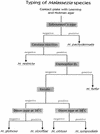Atopic dermatitis and fungi
- PMID: 12364369
- PMCID: PMC126862
- DOI: 10.1128/CMR.15.4.545-563.2002
Atopic dermatitis and fungi
Abstract
Atopic dermatitis (AD) is a chronic, itching, inflammatory skin disease which is associated with asthma and/or hay fever and a familial occurrence of these conditions. Genetic factors are important in the development of AD, but the exact hereditary pathway is still unknown. Dry skin and the weakened barrier function in patients with AD is very important for the patient's reactions to irritants and other external trigger factors including microorganisms. The standard treatments are topical corticosteroids, topical immunomodulating agents, and emollients. If AD cannot be controlled by this type of treatment, systemic immunomodulating agents may be used. UVB, UVA, or psoralen-UVA may also be used for widespread severe lesions. However, some patients do not respond to these standard treatment, and then it is important to consider the role of microorganisms, house dust mites or food. The role of the Malassezia yeasts in AD, especially AD located to the head and neck region, is now documented in several papers. There are also several papers indicating the role of Candida as an aggravating factor in AD. Patients with AD also develop chronic dermatophyte infections more easily, and patients with AD and chronic dermatophyte infections may show improvement in their AD when treated with antifungal drugs.
Figures
Similar articles
-
Pityrosporum ovale in healthy children, infantile seborrhoeic dermatitis and atopic dermatitis.Acta Derm Venereol Suppl (Stockh). 1995;191:1-47. Acta Derm Venereol Suppl (Stockh). 1995. PMID: 7537004
-
[The role of the yeasts Malassezia sp. in etiopathology of atopic dermatitis].Pol Merkur Lekarski. 2005 Feb;18(104):241-4. Pol Merkur Lekarski. 2005. PMID: 17877141 Polish.
-
Ketoconazole in atopic dermatitis: therapeutic response is correlated with decrease in serum IgE.Arch Dermatol Res. 1995;287(5):448-51. doi: 10.1007/BF00373427. Arch Dermatol Res. 1995. PMID: 7625855
-
[Fungi and atopic dermatitis].Nihon Ishinkin Gakkai Zasshi. 1999;40(2):79-83. doi: 10.3314/jjmm.40.79. Nihon Ishinkin Gakkai Zasshi. 1999. PMID: 10234078 Review. Japanese.
-
Framing the future of antifungals in atopic dermatitis.Dermatology. 2003;206(4):398-400. doi: 10.1159/000069968. Dermatology. 2003. PMID: 12771497 Review.
Cited by
-
Role of antioxidants supplementation in the treatment of atopic dermatitis: a critical narrative review.Front Nutr. 2024 Jun 12;11:1393673. doi: 10.3389/fnut.2024.1393673. eCollection 2024. Front Nutr. 2024. PMID: 38933878 Free PMC article. Review.
-
The Role of Malassezia spp. in Atopic Dermatitis.J Clin Med. 2015 May 29;4(6):1217-28. doi: 10.3390/jcm4061217. J Clin Med. 2015. PMID: 26239555 Free PMC article. Review.
-
Gastrointestinal Candida colonisation promotes sensitisation against food antigens by affecting the mucosal barrier in mice.Gut. 2006 Jul;55(7):954-60. doi: 10.1136/gut.2005.084954. Epub 2006 Jan 19. Gut. 2006. PMID: 16423887 Free PMC article.
-
Dandruff: the most commercially exploited skin disease.Indian J Dermatol. 2010 Apr-Jun;55(2):130-4. doi: 10.4103/0019-5154.62734. Indian J Dermatol. 2010. PMID: 20606879 Free PMC article.
-
Atopic Dermatitis and Ulcerative Colitis Successfully Treated with Upadacitinib.Medicina (Kaunas). 2023 Mar 10;59(3):542. doi: 10.3390/medicina59030542. Medicina (Kaunas). 2023. PMID: 36984542 Free PMC article.
References
-
- Abeck, D., and M. Mempel. 1998. Staphylococcus aureus colonization in atopic dermatitis and its therapeutic implications. Br. J. Dermatol. 139(Suppl. 53):13-16. - PubMed
-
- Adachi, A., T. Horikawa, M. Itchihashi, T. Takashima, and A. Komura. 1999. Role of Candida allergen in atopic dermatitis and efficacy of oral therapy with various antifungal agents. Arerugi 48:719-725. (In Japanese, English abstract.) - PubMed
-
- Akiyama, H., J. Tada, Y. Toi, H. Kanzaki, and J. Arata. 1997. Changes in Staphylococcus aureus density and lesion severity after topical application of povidone-iodine in cases of atopic dermatitis. J. Dermatol. Soc. 16:23-30. - PubMed
-
- Arzumanyan, V. G., O. O. Magarshak, and B. F Semenov. 2000. Yeast fungi in patients with allergic diseases: species variety and sensitivity to antifungal drugs. Bull. Soc Exp. Biol. Med. 129:601-604. - PubMed
-
- Arzumanian, V. G. 2001. The yeast Malassezia on the skin of healthy individuals and patients with atopic dermatitis. Vestn. Ross. Akad. Med. Nauk. 2:29-31. (In Russian, English abstract.) - PubMed
Publication types
MeSH terms
Substances
LinkOut - more resources
Full Text Sources
Other Literature Sources
Molecular Biology Databases


